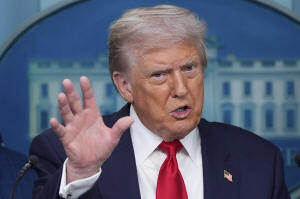US and China extend trade truce another 90 days, easing tension between
world's largest economies
[August 12, 2025] By
PAUL WISEMAN and DIDI TANG
WASHINGTON (AP) — President Donald Trump extended a trade truce with
China for another 90 days Monday, at least delaying once again a
dangerous showdown between the world’s two biggest economies.
Trump posted on his Truth Social platform that he signed the executive
order for the extension, and that “all other elements of the Agreement
will remain the same.” Beijing at the same time also announced the
extension of the tariff pause, according to the Ministry of Commerce.
The previous deadline was set to expire at 12:01 a.m. Tuesday. Had that
happened the U.S. could have ratcheted up taxes on Chinese imports from
an already high 30%, and Beijing could have responded by raising
retaliatory levies on U.S. exports to China.
The pause buys time for the two countries to work out some of their
differences, perhaps clearing the way for a summit later this year
between Trump and Chinese President Xi Jinping, and it has been welcomed
by the U.S. companies doing business with China.
Sean Stein, president of the U.S.-China Business Council, said the
extension is “critical” to give the two governments time to negotiate a
trade agreement that U.S. businesses hope would improve their market
access in China and provide the certainty needed for companies to make
medium- and long-term plans.

“Securing an agreement on fentanyl that leads to a reduction in U.S.
tariffs and a rollback of China’s retaliatory measures is acutely needed
to restart U.S. agriculture and energy exports,” Stein said.
China said Tuesday it would extend relief to American companies who were
placed on an export control list and an unreliable entities list. After
Trump initially announced tariffs in April, China restricted exports of
dual-use goods to some American companies, while banning others from
trading or investing in China. The Ministry of Commerce said it would
stop those restrictions for some companies, while giving others another
90-day extension.
Reaching a pact with China remains unfinished business for Trump, who
has already upended the global trading system by slapping double-digit
taxes – tariffs – on almost every country on earth.
The European Union, Japan and other trading partners agreed to lopsided
trade deals with Trump, accepting once unthinkably U.S. high tariffs
(15% on Japanese and EU imports, for instance) to ward off something
worse.
Trump’s trade policies have turned the United States from one of the
most open economies in the world into a protectionist fortress. The
average U.S. tariff has gone from around 2.5% at the start of the year
to 18.6%, highest since 1933, according to the Budget Lab at Yale
University.
But China tested the limits of a U.S. trade policy built around using
tariffs as a cudgel to beat concessions out of trading partners. Beijing
had a cudgel of its own: cutting off or slowing access to its rare
earths minerals and magnets – used in everything from electric vehicles
to jet engines.

[to top of second column] |

President Donald Trump speaks with reporters in the James Brady
Press Briefing Room at the White House, Monday, Aug. 11, 2025, in
Washington. (AP Photo/Alex Brandon)
 In June, the two countries reached
an agreement to ease tensions. The United States said it would pull
back export restrictions on computer chip technology and ethane, a
feedstock in petrochemical production. And China agreed to make it
easier for U.S. firms to get access to rare earths.
“The U.S. has realized it does not have the upper hand,’’ said
Claire Reade, senior counsel at Arnold & Porter and former assistant
U.S. trade representative for China affairs.
In May, the U.S. and China had averted an economic catastrophe by
reducing massive tariffs they'd slapped on each other’s products,
which had reached as high as 145% against China and 125% against the
U.S.
Those triple-digit tariffs threatened to effectively end trade
between the United States and China and caused a frightening
sell-off in financial markets. In a May meeting in Geneva they
agreed to back off and keep talking: America’s tariffs went back
down to a still-high 30% and China’s to 10%.
Having demonstrated their ability to hurt each other, they’ve been
talking ever since.
“By overestimating the ability of steep tariffs to induce economic
concessions from China, the Trump administration has not only
underscored the limits of unilateral U.S. leverage, but also given
Beijing grounds for believing that it can indefinitely enjoy the
upper hand in subsequent talks with Washington by threatening to
curtail rare earth exports,'' said Ali Wyne, a specialist in
U.S.-China relations at the International Crisis Group. "The
administration’s desire for a trade détente stems from the
self-inflicted consequences of its earlier hubris.”

It’s unclear whether Washington and Beijing can reach a grand
bargain over America’s biggest grievances. Among these are lax
Chinese protection of intellectual property rights and Beijing’s
subsidies and other industrial policies that, the Americans say,
give Chinese firms an unfair advantage in world markets and have
contributed to a massive U.S. trade deficit with China of $262
billion last year.
Reade doesn’t expect much beyond limited agreements such as the
Chinese saying they will buy more American soybeans and promising to
do more to stop the flow of chemicals used to make fentanyl and to
allow the continued flow of rare-earth magnets.
But the tougher issues will likely linger, and “the trade war will
continue grinding ahead for years into the future,’’ said Jeff Moon,
a former U.S. diplomat and trade official who now runs the China
Moon Strategies consultancy.
___
Associated Press Staff Writers Josh Boak and Huizhong Wu contributed
to this story.
All contents © copyright 2025 Associated Press. All rights reserved |